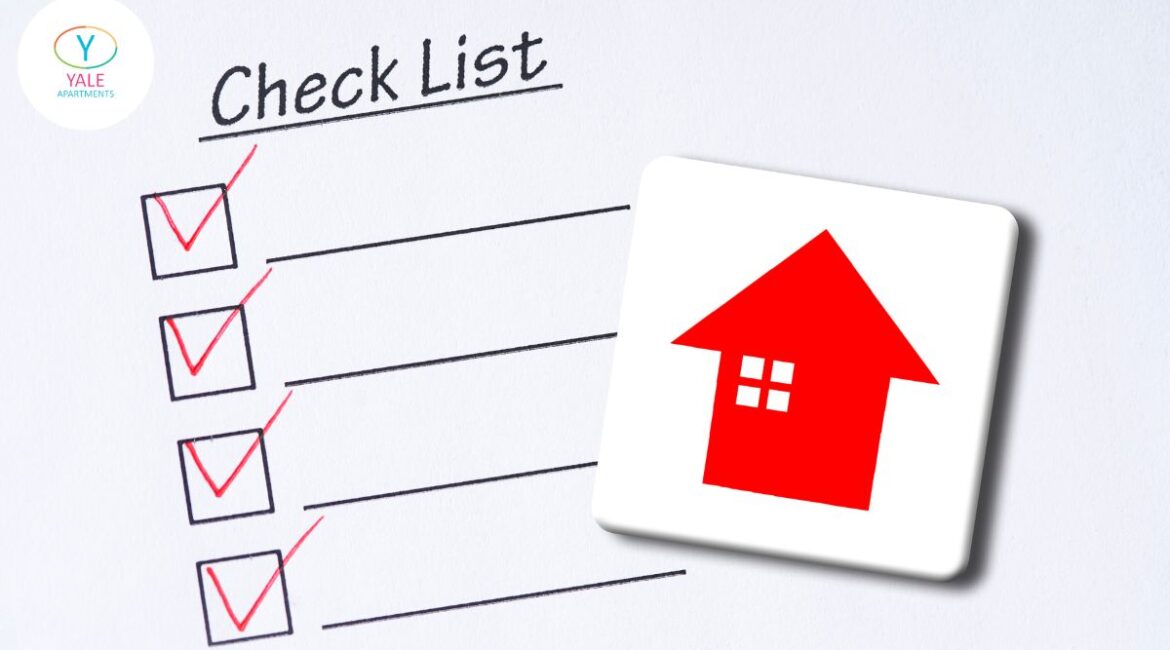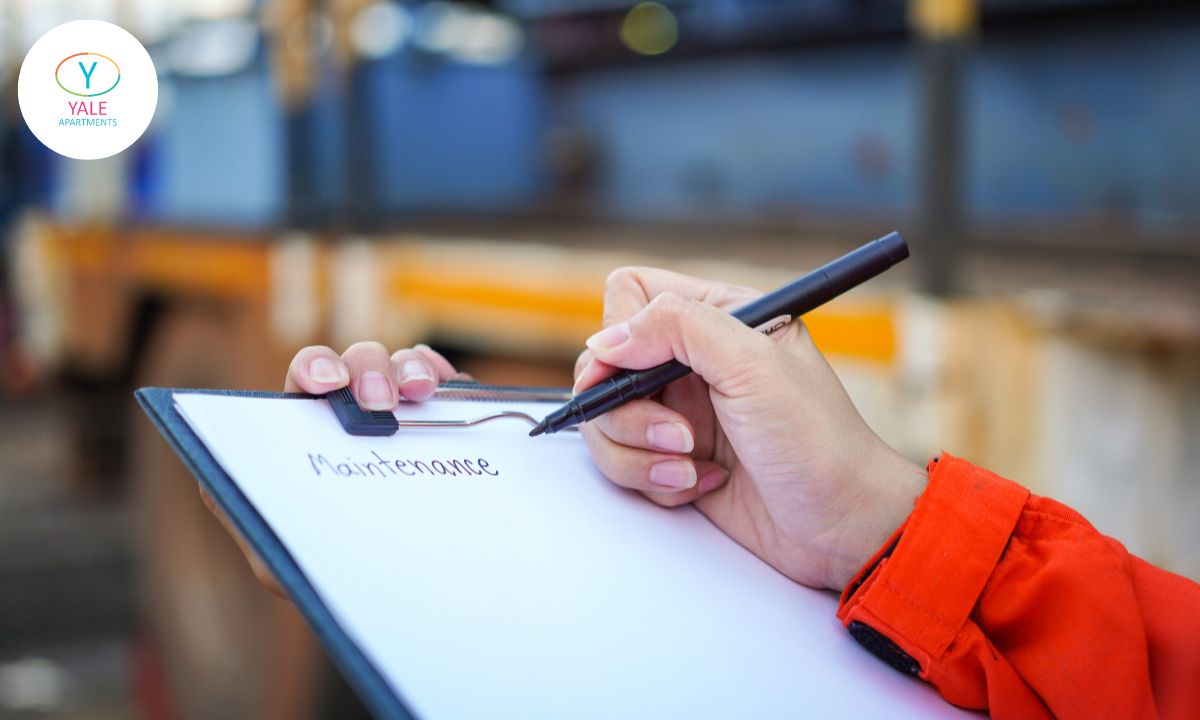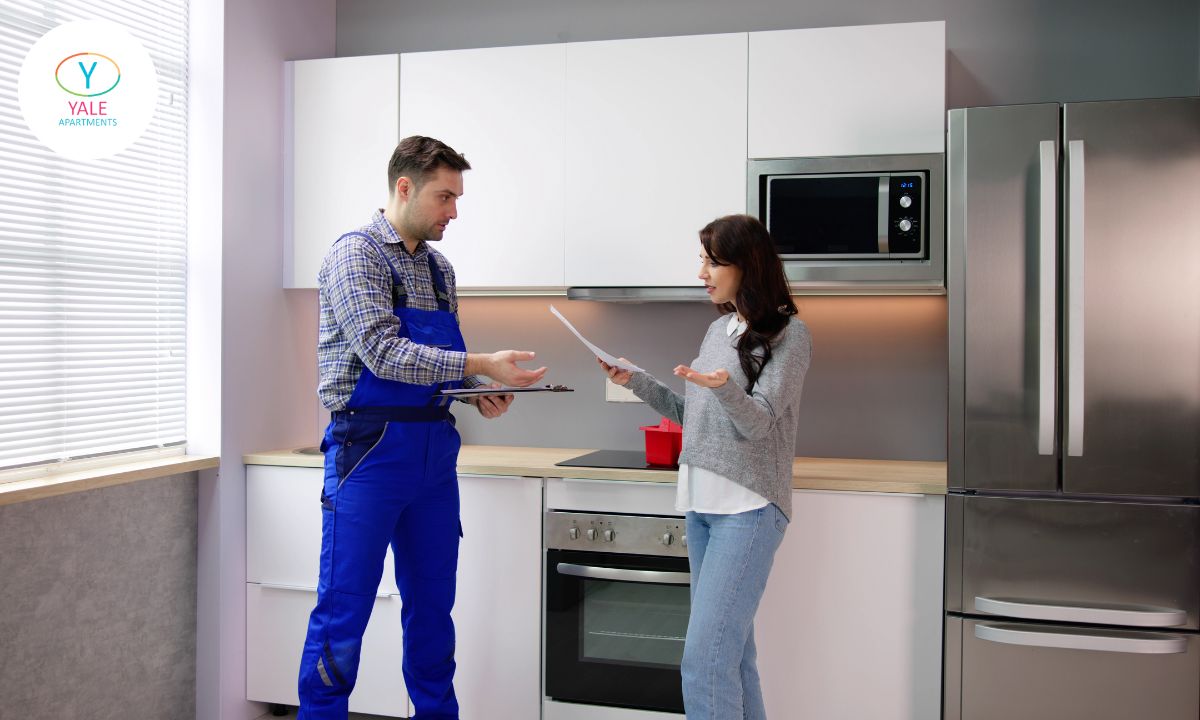
Apartment Maintenance Checklist – A Comprehensive Guide
Maintaining an apartment is like following a detailed plan—it keeps everything in order. An apartment maintenance checklist helps landlords and property managers remember and schedule all the important tasks to keep an apartment in good shape.
It’s like a guidebook for taking care of the place, from small fixes to major checks. Let’s take a closer look at this checklist that keeps apartments running.
What is an apartment maintenance checklist?
An apartment maintenance checklist is a detailed plan or document used by property managers or landlords to keep track of all the tasks needed to maintain an apartment or building. It’s like a guide that helps them remember and schedule important maintenance work.

Think of it as a roadmap for taking care of an apartment. It includes things like checking the plumbing, fixing broken things, making sure appliances work properly, and looking out for any potential problems.
This checklist is super important because it helps property managers stay organized. It ensures they don’t forget any crucial maintenance tasks, so everything in the apartment stays in good shape.
By following this checklist, property managers can catch problems early before they become big issues. This saves a lot of trouble and money because fixing small problems is much easier and cheaper than dealing with big ones.
It’s like having a handy tool that keeps everything running smoothly in an apartment.
Breakdown of Apartment Maintenance Checklist: Step-by-step Guide
Consider what you may discover in an apartment preventive maintenance checklist.

General rental property maintenance
Keeping a rental property in top shape requires thorough inspections and upkeep. Here are some essential checks to ensure the apartment remains in excellent condition:
- Flooring: Look for stains, holes, or damage on the floors, especially if there’s carpet. Fix any issues to keep the place clean and safe.
- Walls and ceilings: Check for chipped paint, holes, or water stains on the walls and ceilings. Fixing these helps avoid bigger problems later on.
- Windows and doors: Make sure windows and doors open smoothly and aren’t damaged. They should work well for security and convenience.
- Appliances: Check that all appliances are working fine. Encourage tenants to take care of them by doing basic maintenance, like cleaning filters.
- Heating and cooling: Make sure the heating and cooling systems are working properly. Regular checks help avoid sudden issues and keep tenants comfortable.
- Plumbing: Inspect faucets and drains for leaks. Fixing leaks saves water and money and prevents damage.
By doing these checks regularly, landlords can keep the rental property in good shape. It makes sure tenants are happy and helps maintain the property’s value.
Exterior lighting and pathway
Making sure outside areas are safe and well-maintained is a part of taking care of apartments, here are a few important things to do:
- Checking outdoor lights: Make sure all the outside lights work well and are bright. Good lights help everyone feel safer, especially at night.
- Keeping pathways clean: Cleaning pathways regularly so there’s no junk or things that could make someone trip. It helps everyone walk around safely.
- Fixing pathway damage: Checking pathways for any broken parts like bricks or stones and fixing them quickly. This keeps the pathways safe to walk on.
- Reporting broken lights: If any lights outside or in common areas aren’t working, it’s important to tell the landlord. Quick fixes mean everyone stays safe and things work better.
Including these tasks in the apartment maintenance checklist helps landlords make sure the outside areas are safe and in good shape for everyone living there.
Porch or balcony
Making sure the porch or balcony is safe and nice for everyone living in the apartments involves a few important things:
- Look for any cracks or rough spots on the floor. Fix them so nobody trips or gets hurt.
- Make sure the stairs aren’t slippery, especially when it’s wet outside. Adding something to make them less slippery can help avoid accidents.
- Check that the railings are strong and don’t wobble. They’re important for keeping everyone safe.
- Take care of any garden or grassy areas attached to the porch or balcony. Keep them tidy and neat by trimming plants and cleaning up debris.
Taking care of these things regularly helps landlords make sure the porch or balcony is a safe and pleasant place for people to relax outside their apartments.
Detectors and security systems
Making sure your safety alarms and security systems work well is really important for keeping everyone safe, here’s what you should do:
- Regularly check your smoke detectors, carbon monoxide detectors, and home security systems to make sure they’re working properly. This ensures they’ll be ready if there’s an emergency.
- Check if the alarms make the right beeping sounds as explained in their manuals. Knowing these sounds helps you understand if there’s a problem.
- Make sure the home security system is working right. If new tenants move in, it might be needed to change the access code for their safety.
- Install detectors on each floor in a multi-story home and near bedrooms. Putting them in the right spots helps them work better in case of an emergency.
HVAC
Taking care of the heating, ventilation, and air conditioning (HVAC) systems is really important for keeping apartments in good shape, here’s what you can do:
- Plan to have someone check your HVAC systems once or twice a year. This makes sure they’re working well and avoids any sudden problems.
- In lots of places, it’s a must to make sure the heating works properly. Especially when it gets cold, checking the heating keeps everyone warm and meets legal rules.
- Once or twice a year, drain the water heater to clean out any bits that build up inside. Doing this keeps the water heater running smoothly for longer.
Why landlords shouldn’t skip regular maintenance?
Landlords have a big job: making sure their rental places are in good shape. Regular maintenance is a huge part of this job—it’s not just fixing things, it’s about keeping everything safe and up to code. These are the reasons why regular maintenance matters:

- Keeping things safe and legal: If landlords don’t keep up with maintenance, it can lead to big problems. Things like broken stuff or unsafe conditions can cause trouble. There might be fines or legal issues if the property doesn’t meet safety rules.
- Saves money and hassle: Doing regular checks and fixes might seem small, but it stops problems from getting worse. Small fixes cost way less and are easier to handle compared to big, expensive repairs.
- Following the rules: Landlords have to follow certain rules about keeping their rental places safe and livable. Regular maintenance helps meet these rules, avoiding conflicts with tenants and legal troubles.
- Protects investments: Rental properties are important investments. Taking care of them keeps their value high. Well-maintained places attract good tenants and allow landlords to charge better rent, making sure the investment stays profitable.
- Happy tenants: When landlords keep things in good shape, it makes tenants happy. This builds trust and makes them want to stay longer, which means less hassle finding new tenants.
Regular maintenance isn’t just about fixing things; it’s about being a good landlord. It keeps everyone safe, and the property in good condition, and helps landlords avoid problems down the road.
FAQs
How to Communicate With Your Tenants About Maintenance?
When there’s maintenance coming up, give tenants simple, clear instructions. And make sure to tell them in advance so they have time to get ready. This way, no one gets surprised, and everyone can plan ahead. When talking maintenance with tenants, remember:
- Set clear rules for sharing updates.
- Offer simple, early instructions for upcoming work.
- Use varied communication methods.
- Track tasks and property conditions.
- Encourage issue reporting for quick resolution.
What are the repair responsibilities of a tenant in a rental property?
The responsibilities of tenants for repairs in a rental property depend on what’s in the lease:
- Tenants usually handle small fixes like changing light bulbs or unclogging drains. They might also need to manage minor wear and tear, like patching small holes in walls.
- However, major repairs and anything related to the property’s structure fall under the landlord’s responsibility.
- The exact details can differ based on what’s agreed upon in the lease, but typically, tenants handle smaller, everyday repairs while the landlord takes care of more significant issues.
How long do landlords have to complete repairs?
- Landlords usually try to fix urgent problems, like big leaks or broken heaters, within a day to keep tenants safe and prevent more damage.
- For less urgent issues, they aim to sort things out within two days, giving enough time to get things fixed.
- Keeping in touch and fixing problems quickly, whether they’re urgent or not, helps landlords and tenants get along better and keeps the place in good shape.
Bottom line
In the world of apartment upkeep, the apartment maintenance checklist is like a guidebook, ensuring everything stays in tune. It covers everything from routine checks to outdoor care, directing landlords to keep their properties in top condition. By following this guide, landlords not only safeguard their property but also foster a good relationship with tenants. Embracing the checklist isn’t just a routine—it’s the way to maintain a safe and happy living space for everyone.

0 Comments